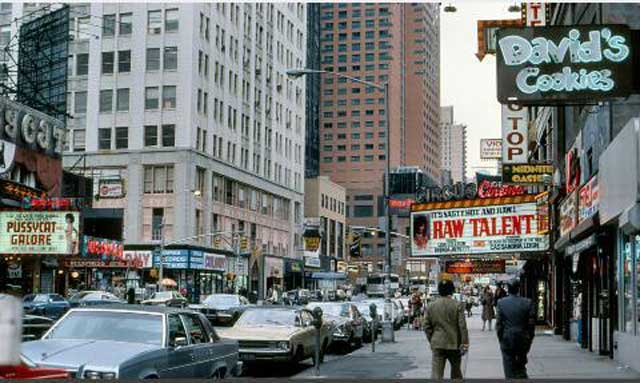Broadway at 49th Street, Manhattan
 |
| Pussycat Theater in 1977. The parade route, which constantly changes, ran down Broadway right past the Pussycat in the late 1970s. |
A lot of things that once seemed normal now would seem quite unusual and even odd. For instance, erotic entertainment was a "thing" back in the day that was present in some surprising places. Times Square has changed quite a bit throughout its history, as any old photographs will quickly show you. It had a very colorful interlude from about the mid-1960s to the mid-1980s which many current tourists probably would never guess. I found the above photo of the Pussycat Theater at 1607 Broadway (49th Street) and wondered how much the property had changed since then. So, I decided to do
a comparison of the Pussycat Theater on Broadway at 49th Street from 1977 to 2019.
 |
| Looking north on Broadway toward 49th Street ca. 1980. The Pussycat Theater is on the west side of Broadway in the middle of this photo. |
The building at 1607 Broadway seen in the 1977 photo was designed by Eugene DeRosa in 1936 to show newsreels. During that time in the days before television networks, newsreels were how many people received their information. The newsreel theater was called Trans-Lux Broadway Theatre and only had one screen for 588 seats. Located on the west side of Broadway between 48th and 49th Streets, it did good business. However, television was on the way, and by the mid-1950s there was no longer a need for a newsreel theater.
 |
| Pussycat Theater in 1981. |
At some point during the 1950s, the Trans-Lux Broadway Theatre began showing motion pictures and other typical theater offerings rather than newsreels. Given its location in Times Square, it was sure to get a lot of "foot traffic," and this was enough to keep it in business.
 |
| Pussycat Theater (just visible on the left) in 1984, with the Brill Building visible just beyond. Apparently, erotic offerings were quite popular at that time in Times Square (Ghislian Bonneau). |
This change in focus proved moderately successful, but during the 1960s, independent theaters everywhere were under pressure. In December 1966, architect Drew Eberson renovated the Trans-Lux Broadway Theater. It reopened as the Trans-Lux West Theatre on April 24, 1967 (it had a sister theater on Third Avenue), and survived in this form for about another decade. However, the 1970s saw the rise of the multiplex and a one-screen theater in a prime location on Times Square just wasn't cutting it. In addition, Times Square was changing with an influx of risque attractions. The Trans-Lux West Theatre closed in the 1970s and reopened as the Grand Pussycat Cinema. It was notable for its neon frontage that shouted "Pussycat" in several different variations.
 |
| Looking north on Broadway toward 49th Street in May 2019. The Pussycat theater would have been on the left (Google Street View). |
The Grand Pussycat Cinema was successful and led to another theater right around the corner on 49th Street called the Kitty Kat Cinema that had been converted from a restaurant. Under this format, the theater survived for about another decade, but New York City building incentives of the mid-1980s proved too powerful for the old theater to survive. By 1987, the Pussycat (and Kitty Kat) had been demolished and replaced by the new Crowne Plaza Times Square Manhattan with a new address of 1605 Broadway. However, its successful struggle to adapt to changing tastes over the course of its existence was a case study in how to survive by giving your customers what they want. It's almost heroic when you think about it.
 |
| Broadway at 49th Street in May 2019 (Google Street View). |
While the building on Broadway just to the north of the Pussycat are still there, including the Brill Building on the northwest corner of Broadway and 49th, there is no trace of the Pussycat. All of the gaudy "Topless" signs are gone, as are the classic old marquees and the zipper that ran above the entrance. However, the souvenir shop on the ground floor where the entrance to the Pussycat used to be at least carries on that age-old tradition of giving the customers of the day what they want. And, these days, those customers are much less likely to be locals looking for what the Pussycat had to offer and more interested in bringing back a miniature Empire State Building to Cologne or Tokyo as a keepsake.
I hope you enjoyed this entry in our "the more things change, the more they stay the same" series. There are virtually no signs of the seedy period that Times Square went through from about 1965-1985, but who knows what the future will bring. Please visit some of our other pages in this series!
2019






No comments:
Post a Comment
Note: Only a member of this blog may post a comment.